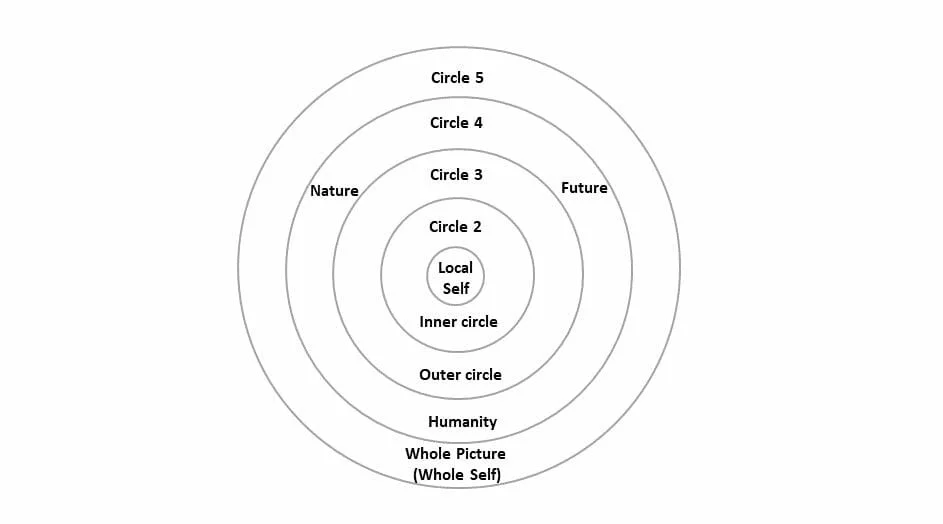Leading In The Age Of Resilience
Image created by the author using Midjourney.
By Ginny Whitelaw.
Originally published on Forbes.com on September 1st, 2023.
Viral pandemics, wind-swept fires, droughts, floods and roiling hurricanes will keep wreaking their havoc on what the brilliant, bestselling author and economist, Jeremy Rifkin, calls a rewilding earth. “We long thought that we could force the natural world to adapt to our species,” Rifkin writes. “We now face the ignominious fate of being forced to adapt to an unpredictable natural world.” While our Industrial Revolutionary past gave rise to the Age of Progress with its focus on efficiency and productivity, we are now in what Rifkin calls in the title of his book, The Age of Resilience, requiring a re-focus on adaptivity and regeneration.
Rikfin makes a compelling case that the Age of Resilience is both now and necessary. It’s not some potential future but already happening in sweeping shifts from growth to flourishing, ownership to access, linear processes to circularity, globalization to glocalization, consumerism to eco-stewardship, gross domestic product (GDP) to quality-of-life indicators (QLI), and more. It’s also necessary because the economic thinking fortifying the Age of Progress ignores a great deal, including the intrinsic value of nature, the laws of thermodynamics and so-called “externalities,” where the true price of progress gets paid. As always, ignorance leads to suffering and our economic ignorance has led to destabilized societies due to vast wealth disparities, destabilized systems trying to deal with the fallout and a destabilized climate increasingly inhospitable to human life. If there is a happy next chapter in the human story amidst this unfolding mayhem, it is because this Age of Resilience also motivates a sea change in leadership. We will find our adaptivity and regenerative spirit in this time inasmuch as we can flip from detached rationality to one-withness, from control to connection and from “It’s all about me” to “I’m all about it.”
Words cannot do justice to the experience of one-withness or samadhi, yet chances are good you’ve had it many times. Being awestruck by the stars or the beauty of nature, or losing oneself in a good book or movie, or getting totally absorbed in a sport or performance—these are all examples of a conditional samadhi. During this time, which feels like no time at all, we’re not thinking about ourselves, our troubles or our to-do list. We are simply, expansively one-with what’s present. And then we re-crystallize back into our seemingly separate self so readily we don’t notice, much less question, the shift. Through regular meditation practice, the samadhi experience deepens, expands and becomes less conditional, while the crystallizing back into a particulate self becomes more noticeable and less welcome. We increasingly experience our paradoxical nature; to borrow a physics metaphor, we are both particle and wave. We are a particular being and body and also a boundaryless wave interpenetrating all existence. We are specific and universal, matter and energy, material and spiritual, bound in space-time and free of space-time. Again, this doesn’t arrive as a belief we need to hold, but as a felt sense, a deep remembering or “aha!” around who we are that engenders unshakeable resilience and a freer way to play the game of life.
Once we remember our connected self, we don’t feel the same need to control. Sure, we still have to meet the needs that come with having a particular human existence, such as air, water, food, shelter, love, self esteem and so on. But having the experience of our universal nature running through our particular self, we more readily discern when those needs are met well enough, rather than falling into unfillable holes of greed. Rather than using the resources of life to serve our particular existence, we can use our particular existence as the platform from which to serve life. In other words, we flip from “It’s all about me,” to “I’m all about it.”
This flip in leadership does not necessarily require Zen or the flash remembering of our whole self nature. It’s akin to servant leadership or steward leadership and can emerge through a more gradual maturing process by which leaders cast an ever-wider net of concerns to consider in their decisions and serve in their actions—e.g., from self to family, to team, organization, nature, society, humanity, the future. One way to get a feel for this flip is to draw an actual set of expanding circles and imagine shapeshifting into different perspectives around an important question. Here is a way to do that.*
1. State a leadership goal or query of some significance that you’re currently pondering, starting with the phrase, “How to…”
2. Draw 5 concentric circles, labeled as in the figure. In the inner circle, fill in several names of people or groups directly related to this goal. Add more names to the outer circle of others (e.g., colleagues, customers, clients, communities, competitors) who might help or block this goal or benefit from it in some way.
3. Starting at the center with your local self, write 2-3 ways you’re approaching this goal currently.
4. Using your pen as an arrow, without looking, land on a name in circles 2, 3 or 4 and imagine yourself shapeshifting into that being or entity, speaking the following:
“Speaking as [name of entity] one of my main issues is [fill in a need of this entity]. This goal could be in my interest if [fill in how this goal could serve]. My best advice right now would be [fill in best advice for pursuing this goal].”
It is surprisingly important to the shapeshifting process to speak these words aloud, not just in your mental voice, and to open with a declaration of who you are speaking as, i.e., who you have become. Take the time you need to completely immerse yourself in this perspective, perhaps changing your posture or movement.
5. Repeat this process 4-5 more times, becoming a voice for at least one perspective from each of circles 2, 3 and 4.
6. Finally, land your pen in the outermost circle and speak for whole picture: “Speaking as the whole picture, one of the needs in this situation is [fill in from a bird’s eye view]. This goal could make the world a better place if[fill in how this goal could serve]. My best advice right now is [fill in best advice for pursuing this goal].”
In addition to insight around your specific goal, you might also notice what changes in your answers from beginning to end or changes in how you feel speaking in different voices. What begins as an act of imagination can deepen into a felt sense of empathy or one-withness as we feel into our wave-like bigness and re-crystallize into different particulate perspectives. This ability to be one-with different perspectives builds the muscle of adaptivity needed in the Age of Resilience. Moreover, to the extent we can draw insight or intuition from the point of view of nature, the future, humanity or the whole picture, the more our actions will have the regenerative quality of life itself.
What better way to deal with the mayhem unfolding around us than being one-with forces that are bigger than it?
Ginny Whitelaw is the Founder and CEO of the Institute for Zen Leadership.


